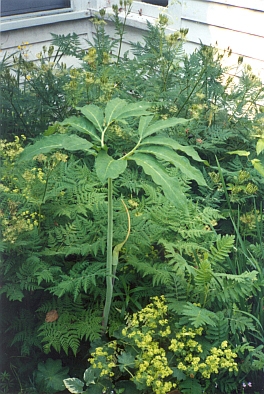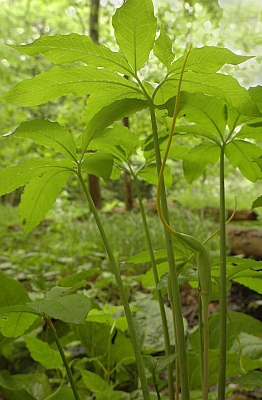Puff the Magic Green Dragon
Characteristics: Green dragons usually have one compound leaf, but it looks as though there are more, with 7-15 leaflets arranged in a semicircle. When viewed from the side, it is possible to imagine a silhouette of dragon wings, with the central leaflet (often a bit lower) as the head. But I have also read that the name may come from the long "serpentine" spadix or that the large corms could look like dragon’s feet.
They grow from 12"-36" high. The yellowish-green sheathed flowers in late spring have a very long slender spadix ("rat’s tail") extending from the top of the spathe. The fruit is a cluster of berries that turn red when ripe. The plant is not self-fertile. The small flowers encircling the spadix are dioecious (individual flowers are either male or female) and are pollinated by flies. I have seen statements that only one sex is to be found on any one plant, so both male and female plants must be grown if seed is required. But most references state that, as with other Arisaema, a specific A. dracontium plant can have flowers of either or both sexes; it "changes sex" from year to year depending on age and conditions, so you just need to have a few plants to produce seeds.
Cautions: Arisaema dracontium contains calcium oxylate crystals. These cause an extremely unpleasant sensation similar to needles being stuck into the mouth and tongue if they are eaten, but they are easily neutralized by thoroughly drying or cooking the plant or by steeping it in water. Some people have skin reactions from handling the plant or seeds.
The second caution is more oblique. There are many wonderful Arisaemas in the world, and many of them are grown by afficianados with good woodland conditions. There are also related plants, such as Pinellias, which are very easily confused with Arisaemas. Pinellias are also grown by many gardeners, and some are well behaved and lovely. But some can be very aggressive in gardens, and could be a problem near natural areas. If you obtain Arisaema dracontium from a friend, or from any sort of garden exchange, please be certain you have the correct plant. And if you have an "imposter", however benign, please be certain that you clearly label it as such, and only give it to equally knowledgeable and responsible friends. (See "Green Dragon or Prolific Imposter?" for more information on the most easily confused species.)Propagation: Arisaema dracontium is easily propagated from seeds. Clean off the pulp, plant the seeds promptly or store cool and moist in the refrigerator. Cullina claims that the seeds will germinate after dry storage, and they need cold stratification for 3-6 months. I just place the cleaned seeds in moist potting mix in a zip lock bag and put them in the refrigerator until early spring, when I move them to warmth under lights. They can bloom in 2-3 years.
Culture & Habitat: Green dragons are native to floodplain forests and edges of marl ponds from Quebec to Minnesota, south to Texas and Florida. Thus it should have moist organic soil in shade. Small offset corms are formed once the original corm gets large; these eventually detach and grow on their own. The best time to move or divide green dragons is in the fall when the plants go dormant. While the green dragon population is apparently safe in the state (S4), it is not that common in Tompkins county. Only move garden specimens, not wild!
References:
- Connecticut Botanical Society
- Plants for a Future
- 2bnthewild.com
- web.grinnell.edu
- Weldy, T. and D. Werier. 2005. New York Flora Atlas. [S.M. Landry, K.N. Campbell, and L.D. Mabe (original application development), Florida Center for Community Design and Research. University of South Florida]. New York Flora Association, Albany, New York.
- Cullina, W., 2000,Growing & Propagating Wildflowers of the United States, NEWFS, Houghton Mifflin.
About
By Rosemarie Parker
Photos by Krissy Faust and Paul Schmitt




